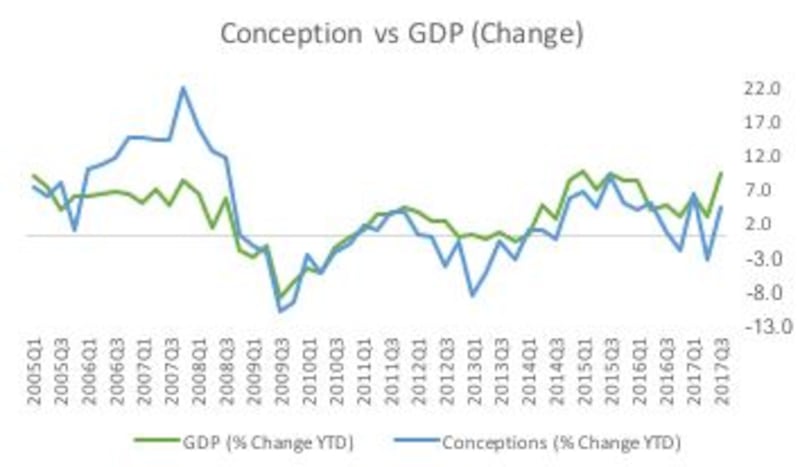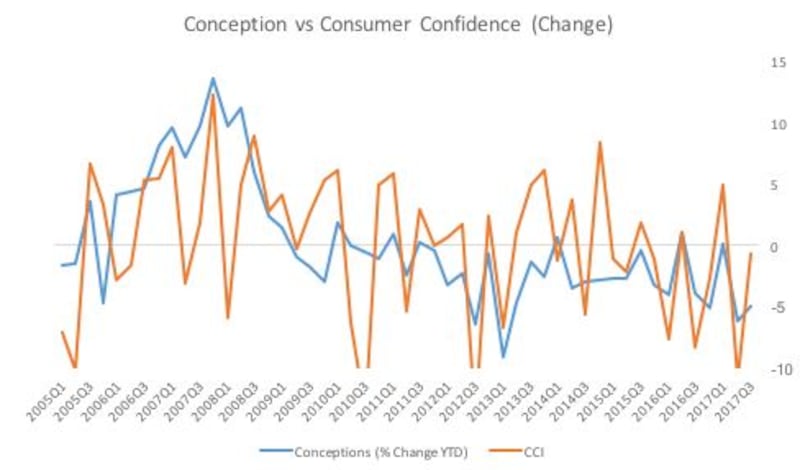Two weeks ago, this column looked at experiments with babies, revealing just how much humans love to be in control of their lives from a very young age. This observation might help explain, decades later, why some adults vote for the guy who appears to be in control, no matter how flawed his character.
This week, as we are heading towards Easter, formerly the pagan fertility festival represented by little rabbits, let’s stick with the baby theme. This time we are going to explore how much babies control our adult lives, our decisions, our vision of the future and the economy itself.
Ultimately, could the number of us having babies be one of the most accurate leading indicators of where the economy is likely to go in the future?
The collapse in birth rates in Russia and in other former Soviet countries during the 1990s and 2000s was unprecedented
This issue has fascinated me for some years, probably since I lived in Russia during the collapse of communism, when the essential fabric of Russian society was torn asunder. Russians stopped having children at the rates they had previously done, and many of my own friends there appeared to simply give up on the future.
In middle-income countries, when people who have control over their fertility feel the economy is not able to offer children a good future, large numbers choose not to have babies.
The collapse in birth rates in Russia and in other former Soviet countries during the 1990s and 2000s was unprecedented.
Admittedly, the Soviet experience was extreme but the question is still valid. Is having a child an indicator of where we think the economy is going? If it is, economists had better get themselves to maternity wards pronto.
Let’s look at whether the birth rate is an economic indicator and the impact of having children on gross domestic product (GDP). Can having babies tell us something about the economy and, more interestingly, does a high birth rate mean that the economy is going to boom in the years ahead?
New research published this week in the United States suggests this theory has merit.
Looking at the past few recessions in the US, economists have found a direct relationship between changes in people deciding to have children and changes in the economic cycle. Parents, sensing that things are looking up a bit, decide to have kids, and a year or so after the kids are born the economy does indeed take off. Therefore, people’s hunches about a coming upswing tend to be right.
Conception rates
In contrast, the numbers also show that people don’t have children if they sense things might be about to go pear-shaped and conception rates fall before the downturn hits.
(It shows not only that fewer births precede a recession, but also that the fall in births is not related to a spike in terminations; people plan and conceiving less.)

This means lots of ordinary people have a sixth sense about the economy. Economists shouldn’t say this too loudly because if the average couple has this sense, where does it leave the boffins with all their models, equations and PhDs?
Is the birth rate a leading indicator in Ireland? We get some interesting results, not totally conclusive but significant nonetheless, particularly on the downside.
If you look at births just before the economy collapsed in late 2008 and 2009, we see that people did in fact sense something. Irish births peaked in the first quarter of 2007 and started to fall rapidly after that. Birth rates fell quicker than GDP for nearly two years before GDP started to collapse.
Having babies and consumer confidence, two indicators that measure how people feel about the future, move in tandem
In 2007, the birth rate and its correlation with the economy was unambiguous in Ireland. People sensed something wasn’t right and many stopped having kids. This continued right up to the end of the recession in 2013. Since then, the birth rate has recovered but not nearly as quickly as GDP. We could be having what might be called a “babyless” recovery.
But looking more closely, if you compare the birth rate with the most commonly used leading indicator, consumer confidence, they move closely in tandem. So having babies and consumer confidence, two indicators that measure how people feel about the future, move in tandem.

Since the recession, the birth rate has recovered strongly but not as strongly as GDP, and yet birth rates have led consumer confidence. And, as consumer confidence tells us about the domestic economy, retail sales, local employment, house building and thus incomes, the birth rate is clearly a valuable indicator of the national economy.
Now why is this important?
Crucial area
Knowing where the economy is likely to go is the single most important area of economics, as it’s the bit of the business that purports to tell us about the future. For example, last week the new head of the Federal Reserve, Jay Powell, got up to speak to Congress and millions of people listened intently to hear where he thought the US economy was headed. This will determine where interest rates go and thus determine asset prices in the short term.
In the financial markets, you get this right, place the right bet and you make a fortune. Get this wrong and you face bankruptcy.
We injected a bit of common sense into highfalutin economic models
Economists have spent a huge amount of time looking for “leading indicators”, the phenomena that occur within the economy ahead of an upswing or a downturn. In a subject that can tie itself up in needless complexities, sometimes simpler is better.
For example, years ago when I worked on forecasting in the Central Bank on Dame Street, as well as lots of data from the economy, we used to count cranes in the Dublin skyline. The more cranes today, the more growth tomorrow. By doing this we injected a bit of common sense into highfalutin economic models.
If economists visited a maternity ward occasionally and counted the newborns, it might introduce a welcome human dimension to the science of prediction.












